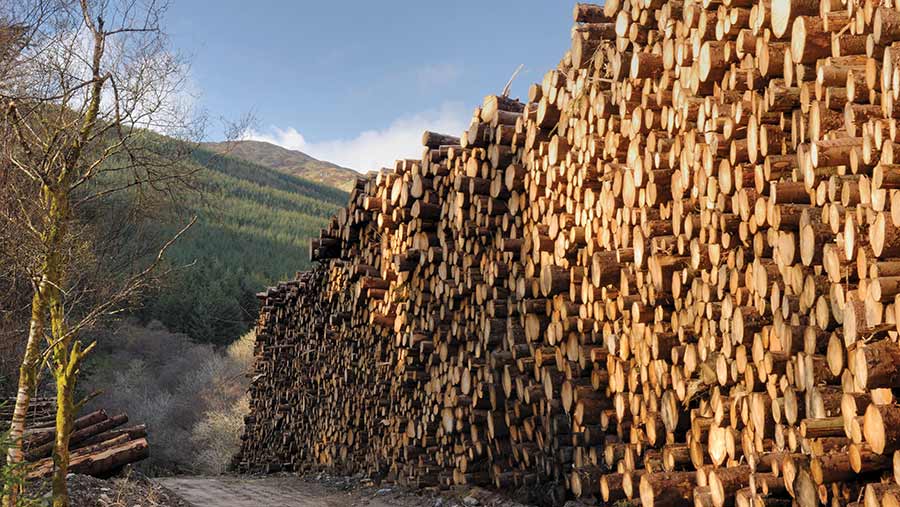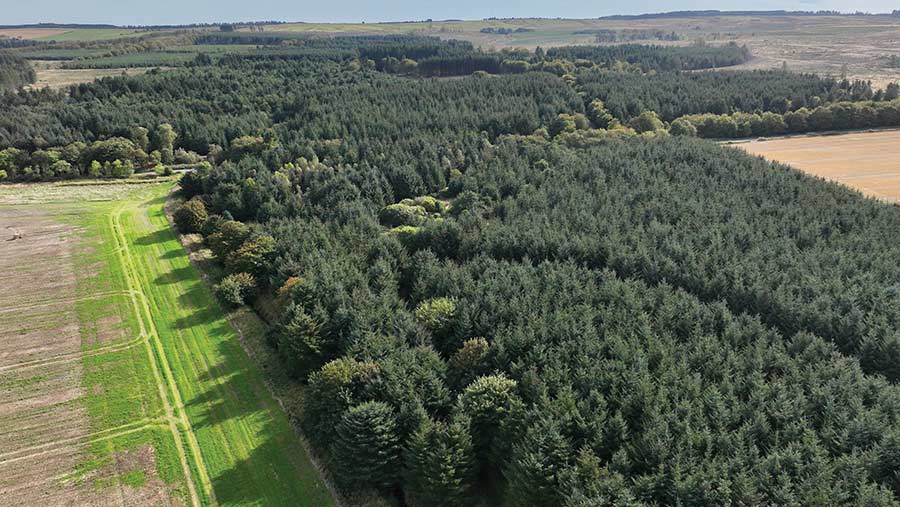Forestry land sales fall in volume and price
 © Tilhill
© Tilhill Sales of commercial forestry land plummeted to record low levels in the first nine months of 2023, with John Clegg & Co reporting an 80% drop in UK sales during that period.
According to its interim Forest Market Review 2023, which covers blocks of more than 20ha sold in the year to 30 September, 2,300ha of forestry land was sold, worth a total £43m.
See more: Expert advice for making trees work on your farm
Sales have followed the same geographical pattern as previous years, with Scotland seeing the most activity.
However, Simon Hart, head of forestry in Scotland for specialist agent John Clegg & Co, says greater caution had crept into the market.
“Lower timber prices, higher interest rates and continued economic uncertainty mean that forestry investors are looking for greater returns on capital, and that means they are looking to pay lower prices for the asset,’’ he adds.
Vendor caution
Owners are sitting tight too.
Alex Brearley, head of forestry and natural capital at the same firm, says since most forestry investors have no debt, they are willing to take a long-term view, and this means when values fall, they are under no pressure to sell.
“While the John Clegg & Co data set contains only those off-market transactions we are aware of, the feeling among most forestry agents is that much less has sold privately in 2023 than in recent years,’’ says Alex.
This is also reflected in the UK Forest Market Report 2023 produced by Tilhill and the Goldcrest Land & Forestry Group, and covering the 12 months to 31 August 2023.
That report confirms commercial forestry values fell for the first time in almost a decade, by 10-20%.
The report highlighted the enduring resilience of UK forestry, the continuing emergence of new investors, and confidence in the long-term future of timber underpinned by the need to replace plastic, steel and concrete with sustainable forest products.

Lenabo Forest © Tilhill
Buyers more selective
However, it found that supply had tightened, prices had dropped, and buyers had become increasingly selective in the last year.
Goldcrest partner Jon Lambert says most properties brought to the market had still sold, but after what had been a “staggering” run, pricing was down 10-20%, depending on quality and location.
“Purchasers are generally more cautious than 12 or 18 months ago, leading to longer due diligence periods, an increased demand to rectify ‘blemishes’ before completion and a desire for higher yields,’’ he says.
Demand for timber had also slowed sharply in the short term, leading to a dramatic reduction in processing volumes.
The report estimates the total value of all commercial forestry listed on the open market in the 12 months to 31 August 2023 at £212m, a 9% increase on the year.
Two properties accounted for 70% of the total value listed for sale – Griffin in Perthshire and Glen Shira in Argyll.
At just 35 properties, the number of listings in the 12-month period had fallen by 39%, well below the historical range, while total value of planting land listings amounted to £49.9m, down 24%, says Jon.
Hunt for quality
Although there was continuing demand for good quality planting land, appropriate sites were hard to find, he adds.
“In summary, 2023 has seen changes in the commercial forestry market with decreased timber prices, a reduction in properties coming to the market and increasingly particular buyers.
“But it remains resilient. Forestry is still sought after,’’ he says.
The report calls for the sector to work together to change public attitude to Sitka spruce.
“It is, after all, the industry’s commercial crop and the workhorse of our timber industry,” the report says.
“Given the urgent need to grow more UK timber – and meet climate mitigation obligations – we must address how the timber industry can make Sitka spruce more palatable.”
Declining confidence has also hit planting rates. Just 13,000ha of trees were planted in the UK in the year to 31 August 2023, a drop of 7%, and 43% below the national tree planting target of 30,000ha.
At 8,200ha, the greatest acreage has been planted in Scotland – more than two-thirds of this was planted with conifers – but this was down 27% on 2022 figures.
Broad-leaf planting accounted for 51% of all UK tree planting.
Slump in planting land price
The most significant development across all forest market data has been the dramatic decline in commercial planting land prices in Scotland, down 22% from 2022 to £9,900/ha.
In contrast, pricing for land suitable for commercial forestry in both England and Wales has increased 42% to £16,600/ha and £13,400/ha respectively.
Kallan Martin, forestry investment advisor at Tilhill, says the countrywide average in Wales, which includes more expensive properties in north Wales and close to the English border, hides the reality that pricing for land most likely to be purchased for forestry is down around 10% to £10,000-£11,000/ha.
He describes statistics for England as “somewhat meaningless’’ given that just 4% of UK conifer planting was carried out on land in England last year.
The report found that land listed for sale which could offer natural capital potential reached £276m, up by 241%, dwarfing the land suitable for commercial forestry.
In this sector, England had the biggest market by value with £144.5m, while Scotland had the most land available at 13,394ha. Prices were highest in Wales at £17,000/ha, although this was due to a combination of agricultural and national park value.
Mixed woodland values
Mixed woodland listings overall were down 18% at £15.8m, and the average price of these fell by 14% to £12,500/ha.
In England, the total value of those listings fell by 45% and there was a 48% drop in total area, but the number of mixed woodlands listed for sale rose to 16 and there was a 5% rise in average value to £17,300/ha.
In Wales, listings rose from three to 10.
Average values for mixed woodland remained almost static in Scotland and Wales at £9,500/ha and £9,600/ha respectively.
Stocked land back 20% from peak
John Clegg & Co’s data suggests an average selling price of £21,900/stocked ha, 6% higher than the £20,800 achieved in 2022, but below 2021’s record levels when values soared to £26,600/stocked ha.
The correlation between lower timber prices and lower property values is particularly pronounced, says Simon.
“When timber prices spiked during the Covid-19 pandemic, so did plantation prices. As timber prices have eased, so too have commercial forestry values.’’
Although the company’s analysis points to higher average prices, that comes with the caveat that the data set is very small and is affected by differences in the size, age and quality of forests sold between years, he says.
“A more realistic assessment is that values are generally 10-20% lower than they were at the peak of the market, but still more than double what they were in 2018.”
Buyers still hunting
While demand has weakened, John Clegg & Co says there remains a surplus of capital looking for the right investment opportunities, reflected by 69% of the forests so far sold in 2023 finding a buyer within six months of marketing; this is more than during 2022 when the market was more active.
For the long term, expectations are upbeat, with global timber demand expected to more than double by 2050 as the construction industry increasingly looks to wood as a way of decarbonising.
Alex is confident about timber prices in the longer term and, as a consequence, commercial forestry values.
“Provided there are no major shocks to the economy, we expect steadily rising woodland values over the long term.”
A more detailed analysis of the commercial forestry market in 2023 will be published in March next year.
The Forest Market Review is based on completed sales of commercial forestry properties, so predominantly conifer, of 20ha or more in Great Britain which have been publicly or privately marketed in the calendar year.
